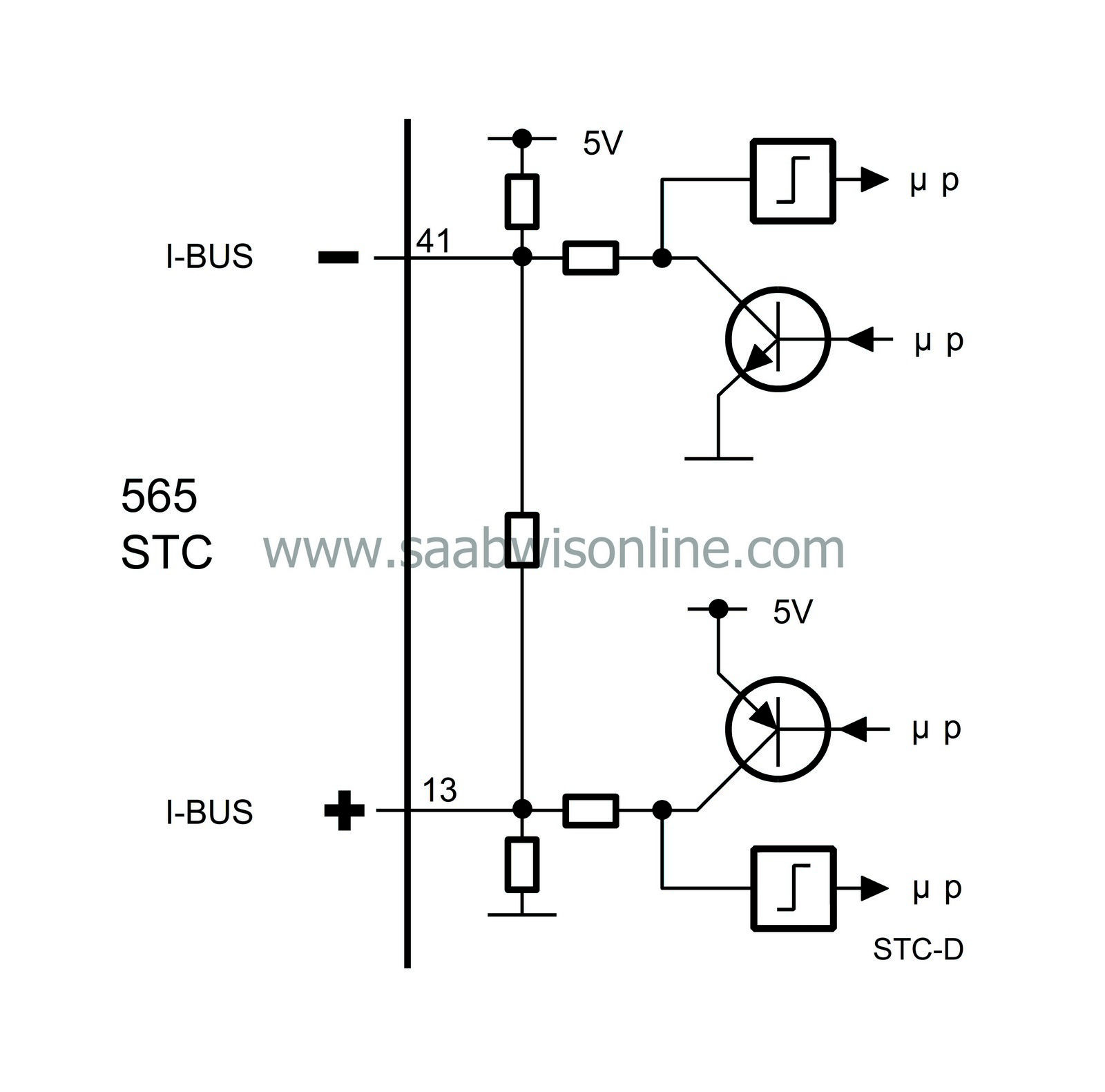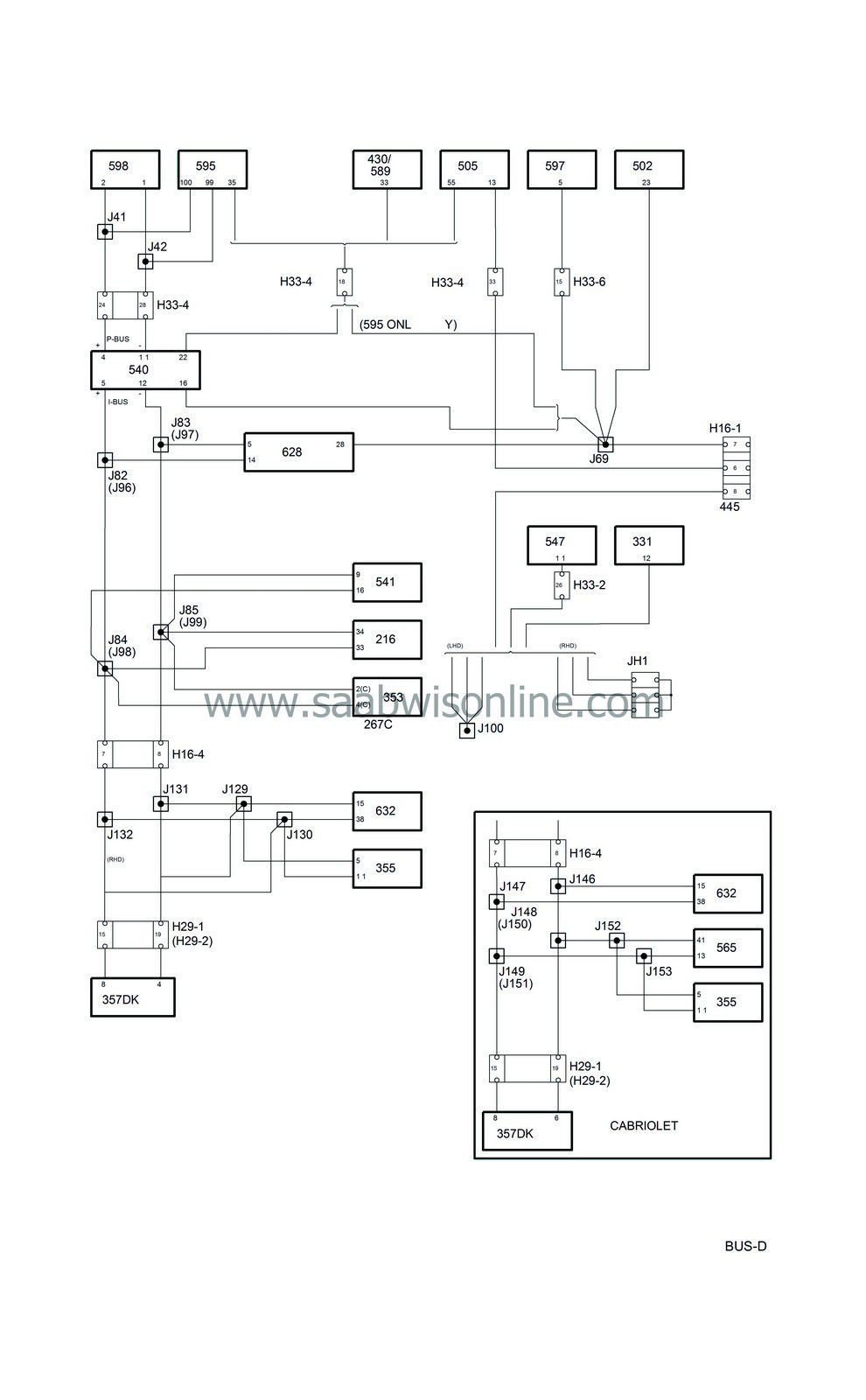Bus communication
| Bus communication |
| • |
Control module, ACC (216)
|
|
| • |
Radio connector C (267c)
|
|
| • |
Control module, airbag/SRS (331)
|
|
| • |
Radio (353)
|
|
| • |
CD changer (355)
|
|
| • |
Control module PSM (357Dk)
|
|
| • |
Control module Trionic (430)
|
|
| • |
Control module TCM (502)
|
|
| • |
Control module M2.10.3 (505)
|
|
| • |
MIU (540)
|
|
| • |
SID (541)
|
|
| • |
Control module ABS (547)
|
|
| • |
Control module STC (565)
|
|
| • |
Control module Trionic OBDII (589)
|
|
| • |
Control module EDC 15 (595)
|
|
| • |
Control module auxiliary heater (597)
|
|
| • |
Diesel pump (598)
|
|
| • |
Control module DICE (628)
|
|
| • |
Control module TWICE (632)
|
|
| P-bus and I-bus |

A bus is understood to be the leads with which information is sent digitally and serially. Digital means that the voltage difference between the leads has only two values, approximately 0 V and 5 V. The information is coded so that different combinations of 0 V and 5 V pulses have different meanings.
Serial means that the information is sent in ”packets” which are transmitted one after the other in very rapid succession.
Half of the control modules in the Saab 9-3 are connected to the bus.
The bus is divided in a P bus (Powertrain Bus) and an I bus (Instrument Bus). Both buses are connected to the MIU (Main Instrument Unit). The buses are electrically isolated from each other.
The diagnostic tool is not connected directly to the bus but communicates via DICE, one of the control modules connected to the I bus, and so it has access to all control modules connected to a bus.
The data transfer rate of the P bus is ten times faster than that of the I bus. The reason for this is that the powertrain systems need information with a minimum of delay.
All information sent out on a bus by a control module is available to all other control modules connected to the bus. The MIU ensures that the information that is available on one bus is also available on the other.
The control modules send out information on the bus at regular intervals. The time between two transmissions depends on what information is being transmitted and varies between 10 milliseconds (0.010 seconds) and 1 second. Information is also transmitted by the control module whenever the information changes.
The transfer of information between the control modules takes place on two leads, bus+ (green lead) and bus- (white lead). The two leads are twisted to increase tolerance to electrical interference.
| The STC uses the following information |
| STC receives | Values | Sensor system | |
|
Boot lid
|
OPEN / CLOSED
|
TWICE
|
Status of boot lid switch. The STC control module does not allow operation of the soft top when the boot lid is “open”. SID will display “CLOSE TRUNK LID” if an attempt is made to operate the soft top.
|
|
Vehicle speed
|
km/h, mph
|
MIU
|
Wheel speed, rear left (lead from ABS). The STC control module will allow the soft top to be operated only when the vehicle speed is below 10 km/h.
|
| The STC sends the following information |
| STC sends | Values | Used by | |
|
Sound
|
Sound information
|
SID
|
SID will sound an acoustic signal when a text message is displayed and when the roof has completed its movement sequence.
|
|
Text message
|
Text information
|
SID
|
In case of a malfunction, SID will display an error message.
|
|
Soft top position
|
Raised, In motion, Lowered
|
ACC, TWICE
|
Switches in top of windscreen frame, Soft top cover switches. The ACC changes its state when the soft top is opened. TWICE will not unlock the boot lid if the soft top is not completely raised or not completely lowered. SID will display “FINISH SOFT TOP MOTION” if an attempt is made to open the boot lid while the soft top is in motion.
|
|
Diagnostics communication
|
--
|
DICE/diagnostics tool
|
|



